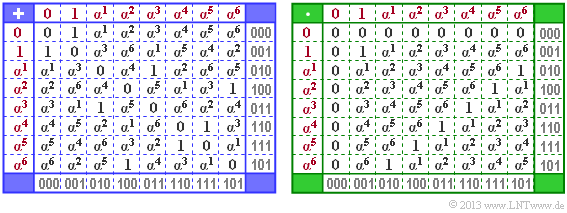Exercise 2.08Z: Addition and Multiplication in GF(2 power 3)
From LNTwww
The graph shows the addition and multiplication table for the finite field $\rm GF(2^3)$. The tables are not complete. Some fields $($highlighted in color$)$ should be completed.
The elements are given both
- in the exponent representation $($with red lettering, left and above$)$ and
- in the coefficient representation (gray lettering, right and below).
From this assignment one can already recognize the underlying irreducible polynomial $p(\alpha)$.
- Additions $($and subtractions$)$ are best done in the coefficient representation $($or with polynomials firmly linked to it$)$.
- For multiplications, however, the exponential representation is more convenient.
Hints:
- This exercise belongs to the chapter "Definition and Properties of Reed-Solomon Codes".
- However, reference is also made to the chapter "Extension Field".
Questions
Solution
(1) Adding any element of an extension field based on $\rm GF(2)$ to itself always yields $0$, as can be easily seen from the coefficient representation, for example:
- $$\alpha^3 + \alpha^3 = (011) + (011) = (000) = 0 \hspace{0.05cm}.$$
- That is: $\rm A$ stands for the zero element ⇒ Solution 1.
(2) $\rm B$ is the result of adding $\alpha^5$ and $\alpha^6$ ⇒ Solution 3:
- $$\alpha^5 + \alpha^6 = (111) + (101) = (010) = \alpha^1 \hspace{0.05cm}.$$
- One could have found this result more simply, since in each row and column each element occurs exactly once.
- After $\rm A = 0$ is fixed, exactly only the element $\alpha^1$ is missing in the last row and the last column.
(3) $\rm C$ is the result of the sum $\alpha^1 +\alpha^2$ ⇒ Solution 3:
- $$\alpha^1 + \alpha^2 = (010) + (100) = (110) = \alpha^4 \hspace{0.05cm}.$$
(4) $\rm D$ is the result of $\alpha^3$ and $\alpha^5$ ⇒ Solution 1:
- $$\alpha^3 + \alpha^5 = (011) + (111) = (100) = \alpha^2 \hspace{0.05cm}.$$
(5) All proposed solutions are correct, as can be seen from row 2 (multiplication with the "identity element"):
- The complete tables for addition and multiplication are shown opposite.
- Because of the validity of $\alpha^i \cdot \alpha^j = \alpha^{(i+j)\hspace{0.1cm} {\rm mod}\hspace{0.1cm} 7} $, multiplication yields a symmetry that could be used to solve.
(6) Correct here is the proposed solution 3:
- All polynomials are indeed irreducible. However, one needs a degree-3 polynomial for $\rm GF(2^3)$.
- The third proposed solution results from the relation
- $$\alpha^3 = \alpha + 1 \hspace{0.3cm}\Rightarrow \hspace{0.3cm} p(\alpha) = \alpha^3 + \alpha + 1 = 0 \hspace{0.05cm}.$$

